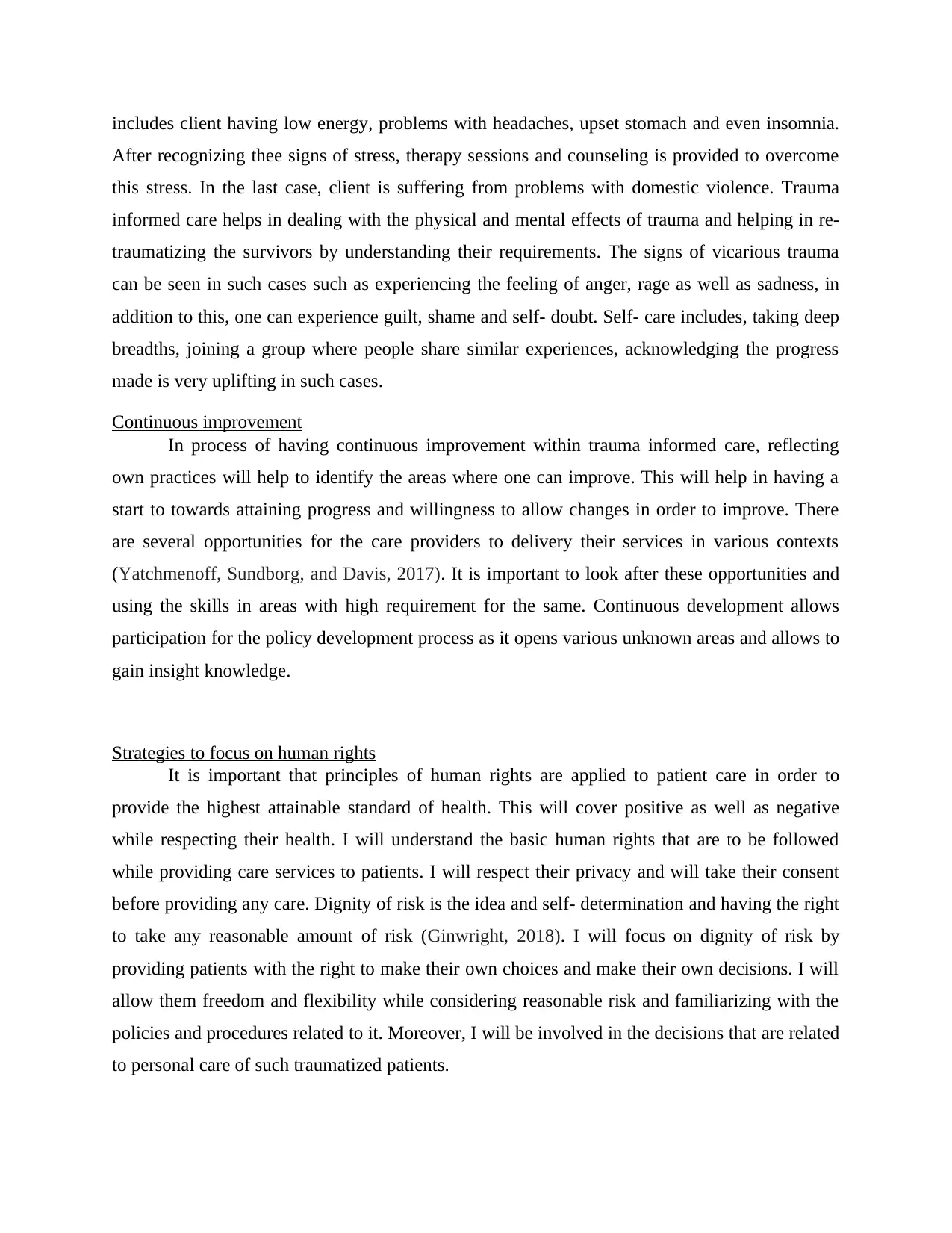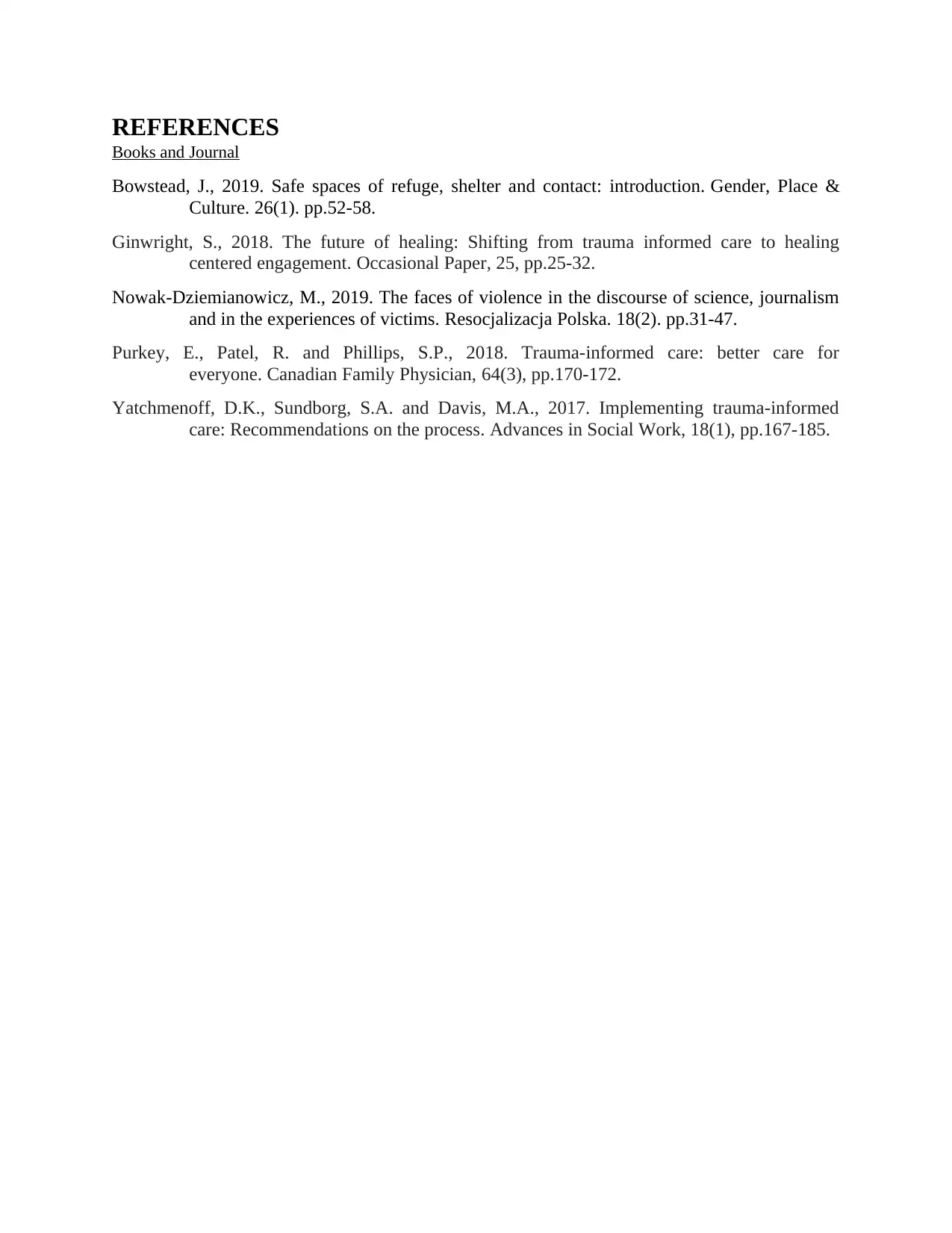Client-Centered Project: Trauma-Informed Care & Human Rights Focus
VerifiedAdded on 2023/06/17
|6
|1447
|320
Project
AI Summary
This project comprehensively analyzes three distinct client scenarios—homelessness, child abuse, and domestic violence—through the lens of trauma-informed care. It identifies the unique challenges each client faces, emphasizing the importance of understanding the impact of trauma on their well-being. The project details specific safety measures and self-care strategies tailored to each situation, highlighting the necessity of family support, collaborative practices, and effective communication. Furthermore, it underscores the significance of continuous improvement in care practices through reflection and policy engagement, while also prioritizing human rights by ensuring patient privacy, consent, and dignity of risk. The project ultimately aims to provide practical guidance for healthcare professionals and caregivers in delivering compassionate and effective trauma-informed care.

ASSESSMENT TASK 3 -
PROJECT
Table of Contents
PROJECT
Table of Contents
Paraphrase This Document
Need a fresh take? Get an instant paraphrase of this document with our AI Paraphraser

INTRODUCTION...........................................................................................................................................3
TASK ............................................................................................................................................................3
Identify clients with brief background.........................................................................................................3
Identify trauma informed care....................................................................................................................3
Safety measures..........................................................................................................................................4
Self- care strategies.....................................................................................................................................4
Continuous improvement............................................................................................................................5
Strategies to focus on human rights............................................................................................................5
REFERENCES................................................................................................................................................7
TASK ............................................................................................................................................................3
Identify clients with brief background.........................................................................................................3
Identify trauma informed care....................................................................................................................3
Safety measures..........................................................................................................................................4
Self- care strategies.....................................................................................................................................4
Continuous improvement............................................................................................................................5
Strategies to focus on human rights............................................................................................................5
REFERENCES................................................................................................................................................7

INTRODUCTION
This project will discuss the three different client scenarios. Detailed information about
the trauma and the issue will be given in this project. All the available safety measures will be
discussed in this report. Furthermore, different strategies that can support the continuous all the
three clients will also discuss in this project. Different strategic choices that can support the
human rights will also discuss in this project.
TASK
Identify clients with brief background
Client 1
Client feel homelessness when she moved to the new location after the graduatio9n she
started feeling homelessness. At the new location she had not friends and family which made her
feel more like homelessness. Transferring at new location always force the people to face
consequences like loneliness, homelessness and such like of symptoms. As the human being
always require someone to communicate and coordinate about the day to day operation and also
to spend some time. As at the new location there was not anyone whom she can communicate
and coordinate with which made her feel homelessness.
Client 2
This client is facing an issue of child abuse. The client is facing this issue in the school.
The environment of the school due to some bunch of classmates of client made home experience
this huge issue. The students in the class used to abuse the client which made him face the child
abuse issue. This could further impact over the mental condition of the client. Child abuse is a
huge issue and challenge that people and especially children face which completely destroy the
mental state of the children.
Client 3
This client is facing an issue call as domestic violence. Her husband is highly promoting
domestic violence by treating her wrong to his wife. This issue is huge and she is facing this
issue from last two years. Her husband used to enforce the domestic violence after consuming
alcohol. This was a case from last two years that could further completely affect the mental
condition of client.
This project will discuss the three different client scenarios. Detailed information about
the trauma and the issue will be given in this project. All the available safety measures will be
discussed in this report. Furthermore, different strategies that can support the continuous all the
three clients will also discuss in this project. Different strategic choices that can support the
human rights will also discuss in this project.
TASK
Identify clients with brief background
Client 1
Client feel homelessness when she moved to the new location after the graduatio9n she
started feeling homelessness. At the new location she had not friends and family which made her
feel more like homelessness. Transferring at new location always force the people to face
consequences like loneliness, homelessness and such like of symptoms. As the human being
always require someone to communicate and coordinate about the day to day operation and also
to spend some time. As at the new location there was not anyone whom she can communicate
and coordinate with which made her feel homelessness.
Client 2
This client is facing an issue of child abuse. The client is facing this issue in the school.
The environment of the school due to some bunch of classmates of client made home experience
this huge issue. The students in the class used to abuse the client which made him face the child
abuse issue. This could further impact over the mental condition of the client. Child abuse is a
huge issue and challenge that people and especially children face which completely destroy the
mental state of the children.
Client 3
This client is facing an issue call as domestic violence. Her husband is highly promoting
domestic violence by treating her wrong to his wife. This issue is huge and she is facing this
issue from last two years. Her husband used to enforce the domestic violence after consuming
alcohol. This was a case from last two years that could further completely affect the mental
condition of client.
⊘ This is a preview!⊘
Do you want full access?
Subscribe today to unlock all pages.

Trusted by 1+ million students worldwide

Identify trauma informed care
Homelessness is among the major issue face by all such people move to another city due
to education, job and such like of reasons. The impact of this is such that patient face issues like
loneliness, depression and such like of issues. The impact of this is also over the cultural
competencies of the individual (Bowstead, 2019). In order to cure the disease this is important
that family members to provide a complete support to patient. This is important to ensure the
patient that the recovery is possible. Collaborative practices must be adopted in order to cure the
patient.
Child abuse can be solved with support of the family members. The motivation must be
given to patient that cure can be done. Supportive relationship provide a massive help to the
patient. Domestic violence also need the similar level of cure to the patient in order to tackle
down the issue. This can be solved with the complete support of the family members.
Collaborative practices need to ensure in order to cure both the issues.
Safety measures
In order to cure the homelessness, child abuse and domestic violence different safety
measures can be taken. The support of family member is necessary, Listening is an important
part of the medication. Safety of patient can be planned. Managing risk is essential.
Communicating with the patient is all the three scenarios is important in order to treat the patient.
Managing duty of care is also essential for the patient to treat in order to address all these various
respective issues (Nowak-Dziemianowicz, 2019). This become necessary for the patient in all the
three case situation that the family members must ensure a complete care to treat the issue.
Collaboration of family members is must for the patient.
Self- care strategies
In term of case 1, self- care strategies includes the process of accessing support services.
Helping the clients with homelessness can be challenging and demanding. They suffer from the
sense of sadness, anger and being powerlessness. In this case, it is important to provide such
clients with best care and services. The support services for homelessness include, identifying
their needs and providing counseling session along with food banks. The support services also
include emergency housing and shelters. In case of child abuse, self- care strategy is to recognize
the signs leading to the stress of individual (Purkey, Patel, and Phillips, 2018). Signs of stress
Homelessness is among the major issue face by all such people move to another city due
to education, job and such like of reasons. The impact of this is such that patient face issues like
loneliness, depression and such like of issues. The impact of this is also over the cultural
competencies of the individual (Bowstead, 2019). In order to cure the disease this is important
that family members to provide a complete support to patient. This is important to ensure the
patient that the recovery is possible. Collaborative practices must be adopted in order to cure the
patient.
Child abuse can be solved with support of the family members. The motivation must be
given to patient that cure can be done. Supportive relationship provide a massive help to the
patient. Domestic violence also need the similar level of cure to the patient in order to tackle
down the issue. This can be solved with the complete support of the family members.
Collaborative practices need to ensure in order to cure both the issues.
Safety measures
In order to cure the homelessness, child abuse and domestic violence different safety
measures can be taken. The support of family member is necessary, Listening is an important
part of the medication. Safety of patient can be planned. Managing risk is essential.
Communicating with the patient is all the three scenarios is important in order to treat the patient.
Managing duty of care is also essential for the patient to treat in order to address all these various
respective issues (Nowak-Dziemianowicz, 2019). This become necessary for the patient in all the
three case situation that the family members must ensure a complete care to treat the issue.
Collaboration of family members is must for the patient.
Self- care strategies
In term of case 1, self- care strategies includes the process of accessing support services.
Helping the clients with homelessness can be challenging and demanding. They suffer from the
sense of sadness, anger and being powerlessness. In this case, it is important to provide such
clients with best care and services. The support services for homelessness include, identifying
their needs and providing counseling session along with food banks. The support services also
include emergency housing and shelters. In case of child abuse, self- care strategy is to recognize
the signs leading to the stress of individual (Purkey, Patel, and Phillips, 2018). Signs of stress
Paraphrase This Document
Need a fresh take? Get an instant paraphrase of this document with our AI Paraphraser

includes client having low energy, problems with headaches, upset stomach and even insomnia.
After recognizing thee signs of stress, therapy sessions and counseling is provided to overcome
this stress. In the last case, client is suffering from problems with domestic violence. Trauma
informed care helps in dealing with the physical and mental effects of trauma and helping in re-
traumatizing the survivors by understanding their requirements. The signs of vicarious trauma
can be seen in such cases such as experiencing the feeling of anger, rage as well as sadness, in
addition to this, one can experience guilt, shame and self- doubt. Self- care includes, taking deep
breadths, joining a group where people share similar experiences, acknowledging the progress
made is very uplifting in such cases.
Continuous improvement
In process of having continuous improvement within trauma informed care, reflecting
own practices will help to identify the areas where one can improve. This will help in having a
start to towards attaining progress and willingness to allow changes in order to improve. There
are several opportunities for the care providers to delivery their services in various contexts
(Yatchmenoff, Sundborg, and Davis, 2017). It is important to look after these opportunities and
using the skills in areas with high requirement for the same. Continuous development allows
participation for the policy development process as it opens various unknown areas and allows to
gain insight knowledge.
Strategies to focus on human rights
It is important that principles of human rights are applied to patient care in order to
provide the highest attainable standard of health. This will cover positive as well as negative
while respecting their health. I will understand the basic human rights that are to be followed
while providing care services to patients. I will respect their privacy and will take their consent
before providing any care. Dignity of risk is the idea and self- determination and having the right
to take any reasonable amount of risk (Ginwright, 2018). I will focus on dignity of risk by
providing patients with the right to make their own choices and make their own decisions. I will
allow them freedom and flexibility while considering reasonable risk and familiarizing with the
policies and procedures related to it. Moreover, I will be involved in the decisions that are related
to personal care of such traumatized patients.
After recognizing thee signs of stress, therapy sessions and counseling is provided to overcome
this stress. In the last case, client is suffering from problems with domestic violence. Trauma
informed care helps in dealing with the physical and mental effects of trauma and helping in re-
traumatizing the survivors by understanding their requirements. The signs of vicarious trauma
can be seen in such cases such as experiencing the feeling of anger, rage as well as sadness, in
addition to this, one can experience guilt, shame and self- doubt. Self- care includes, taking deep
breadths, joining a group where people share similar experiences, acknowledging the progress
made is very uplifting in such cases.
Continuous improvement
In process of having continuous improvement within trauma informed care, reflecting
own practices will help to identify the areas where one can improve. This will help in having a
start to towards attaining progress and willingness to allow changes in order to improve. There
are several opportunities for the care providers to delivery their services in various contexts
(Yatchmenoff, Sundborg, and Davis, 2017). It is important to look after these opportunities and
using the skills in areas with high requirement for the same. Continuous development allows
participation for the policy development process as it opens various unknown areas and allows to
gain insight knowledge.
Strategies to focus on human rights
It is important that principles of human rights are applied to patient care in order to
provide the highest attainable standard of health. This will cover positive as well as negative
while respecting their health. I will understand the basic human rights that are to be followed
while providing care services to patients. I will respect their privacy and will take their consent
before providing any care. Dignity of risk is the idea and self- determination and having the right
to take any reasonable amount of risk (Ginwright, 2018). I will focus on dignity of risk by
providing patients with the right to make their own choices and make their own decisions. I will
allow them freedom and flexibility while considering reasonable risk and familiarizing with the
policies and procedures related to it. Moreover, I will be involved in the decisions that are related
to personal care of such traumatized patients.

REFERENCES
Books and Journal
Bowstead, J., 2019. Safe spaces of refuge, shelter and contact: introduction. Gender, Place &
Culture. 26(1). pp.52-58.
Ginwright, S., 2018. The future of healing: Shifting from trauma informed care to healing
centered engagement. Occasional Paper, 25, pp.25-32.
Nowak-Dziemianowicz, M., 2019. The faces of violence in the discourse of science, journalism
and in the experiences of victims. Resocjalizacja Polska. 18(2). pp.31-47.
Purkey, E., Patel, R. and Phillips, S.P., 2018. Trauma-informed care: better care for
everyone. Canadian Family Physician, 64(3), pp.170-172.
Yatchmenoff, D.K., Sundborg, S.A. and Davis, M.A., 2017. Implementing trauma-informed
care: Recommendations on the process. Advances in Social Work, 18(1), pp.167-185.
Books and Journal
Bowstead, J., 2019. Safe spaces of refuge, shelter and contact: introduction. Gender, Place &
Culture. 26(1). pp.52-58.
Ginwright, S., 2018. The future of healing: Shifting from trauma informed care to healing
centered engagement. Occasional Paper, 25, pp.25-32.
Nowak-Dziemianowicz, M., 2019. The faces of violence in the discourse of science, journalism
and in the experiences of victims. Resocjalizacja Polska. 18(2). pp.31-47.
Purkey, E., Patel, R. and Phillips, S.P., 2018. Trauma-informed care: better care for
everyone. Canadian Family Physician, 64(3), pp.170-172.
Yatchmenoff, D.K., Sundborg, S.A. and Davis, M.A., 2017. Implementing trauma-informed
care: Recommendations on the process. Advances in Social Work, 18(1), pp.167-185.
⊘ This is a preview!⊘
Do you want full access?
Subscribe today to unlock all pages.

Trusted by 1+ million students worldwide
1 out of 6
Related Documents
Your All-in-One AI-Powered Toolkit for Academic Success.
+13062052269
info@desklib.com
Available 24*7 on WhatsApp / Email
![[object Object]](/_next/static/media/star-bottom.7253800d.svg)
Unlock your academic potential
Copyright © 2020–2025 A2Z Services. All Rights Reserved. Developed and managed by ZUCOL.





